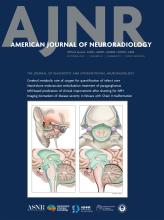Jump to comment:
- Page navigation anchor for RE:RE:
Dear Editor,
We thank Dr. Radaideh and colleagues for their interest in our work1. CSF leaks, particularly when spinal in origin, can not only be debilitating but are underdiagnosed, and more awareness will benefit patient care.
Our study found that skull base CSF leaks do not typically present with clinical symptoms or brain MRI findings associated with spontaneous intracranial hypotension (SIH). The correspondence by Dr. Radaideh and colleagues question whether underlying intracranial hypertension accounts for the absence of brain MRI findings that we associate with spinal CSF leaks causing SIH.
Of the 31 patients with skull base leaks included in our study, 3 (9.7%) had the diagnosis of idiopathic intracranial hypertension (IIH), 15 (48.4%) had a history of trauma or temporal bone surgery, and 13 (41.9%) were classified as spontaneous. Of the spontaneous cohort, 7 had CSF pressure measured (mean 18.8 cm H2O, SD 3.1). As a reference, IIH consensus guidelines use >25 cm H2O as a cutoff.2 Patients with baseline IIH who decompress as a CSF leak could potentially fall below the 25 cm H2O cutoff.
We believe that the more convincing evidence in our work contrary to the letter by Dr. Radaideh and colleagues lies in the 48.4% of patients with trauma or surgery, rather than IIH, that led to the skull base CSF leak. One of these patients had a posterior fossa leak with brain MRI findings of SIH, otherwise the remainder did not. That cohort provides...
Show MoreCompeting Interests: None declared. - Page navigation anchor for RE: Are Skull Base CSF Leaks Different From Spinal CSF Leaks?RE: Are Skull Base CSF Leaks Different From Spinal CSF Leaks?
Dear Editor:
We read with interest the recent article by Mark et al [1] discussing imaging findings in patients with skull base CSF leaks. The authors found that imaging signs of spontaneous intracranial hypotension (SIH) such as pachymeningeal enhancement, cisternal effacement and venous sinus engorgement were absent in most patients with skull base CSF leaks. The authors concluded that skull base and spinal CSF leaks represent different pathophysiologies. While we agree with the authors, that these patients fall into distinct cohorts, we believe that the reader should be aware of some important caveats in this take-home message.
An increasing body of evidence has emerged over the last few years linking CSF leaks, particularly spontaneous CSF leaks from the skull base to intracranial hypertension (IIH) [2]. Skull base remodeling is commonly seen in patients with IIH and predisposes them to CSF leaks in the form of CSF rhinorrhea or otorrhea [3]. In the group of patients studied by the authors, about 10% had proven IIH. More importantly however, about 40% of the patients had spontaneous CSF leaks from the skull base with no apparent cause such as surgery or trauma. Given the association between spontaneous leaks and IIH, it is likely that a significant proportion of these spontaneous cases had undiagnosed IIH; the study though provides little information about this subset of patients. It is unknown whether these 40% patients had elevated opening pressures or...
Show MoreCompeting Interests: None declared.












